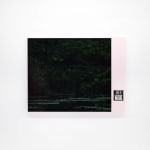Thomas Kuijpers Netherlands, b. 1985
Disk 008, Bridge, 2024
Custom archival print mounted on dibond in pink hand-stained wooden frame with museum glass, mirrored inner edges, and the file on a floppy disk
88 x 100 cm / framed 91,5 x 117 cm
Unique piece
Series: Bridge Project
TK 059
Further images
Nowadays the question of the stability of an original has grown increasingly significant. Since the early 1990s, the digital realm has been siphoning energy away from our physical experiences, prompting...
Nowadays the question of the stability of an original has grown increasingly significant. Since the early 1990s, the digital realm has been siphoning energy away from our physical experiences, prompting a perpetual inquiry into the meaning of an image's relationship to reality. From Plato's allegorical cave to modern databases enabling AI-generated imagery, this issue appears to be approaching a critical juncture, demanding a fresh examination.
For the Bridge project, Thomas Kuijpers worked with a Sony Mavica, the first digital camera encountered, which stored images directly onto floppy disks. In contrast to its analog predecessors, this camera produced data rather than tangible originals like negatives, slides, or Polaroids. At the time, data storage and camera sensors were in their early stages, resulting in a notable reduction in realism compared to contemporary analog cameras. Nevertheless, the immediacy of data acquisition took precedence over image quality, leading people to capture floppy disks filled with abstractly distorted images.
Throughout the year, Thomas carried this camera to Claude Monet's gardens in Giverny, France. These meticulously curated gardens, tended by Monet and his staff, served as the backdrop for many of his iconic artworks. In addition to his numerous water lily paintings, Monet created 24 panels depicting the Japanese Bridge spanning the pond (and 24 panels whilst almost blind). The artist captured photographs of this bridge, which has since been replaced by a replica, in various seasons and times of the year. These images were then meticulously printed using a specialized process, mimicking the dimensions of the original paintings, and framed alongside the original data carrier.
This project was made possible through the generous support of the Mondriaan Fund and in collaboration with the Fondation Claude Monet in Giverny.
For the Bridge project, Thomas Kuijpers worked with a Sony Mavica, the first digital camera encountered, which stored images directly onto floppy disks. In contrast to its analog predecessors, this camera produced data rather than tangible originals like negatives, slides, or Polaroids. At the time, data storage and camera sensors were in their early stages, resulting in a notable reduction in realism compared to contemporary analog cameras. Nevertheless, the immediacy of data acquisition took precedence over image quality, leading people to capture floppy disks filled with abstractly distorted images.
Throughout the year, Thomas carried this camera to Claude Monet's gardens in Giverny, France. These meticulously curated gardens, tended by Monet and his staff, served as the backdrop for many of his iconic artworks. In addition to his numerous water lily paintings, Monet created 24 panels depicting the Japanese Bridge spanning the pond (and 24 panels whilst almost blind). The artist captured photographs of this bridge, which has since been replaced by a replica, in various seasons and times of the year. These images were then meticulously printed using a specialized process, mimicking the dimensions of the original paintings, and framed alongside the original data carrier.
This project was made possible through the generous support of the Mondriaan Fund and in collaboration with the Fondation Claude Monet in Giverny.





